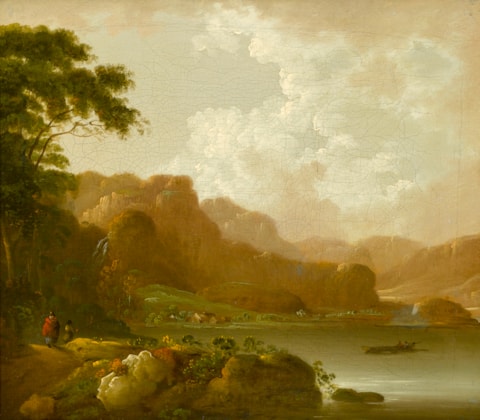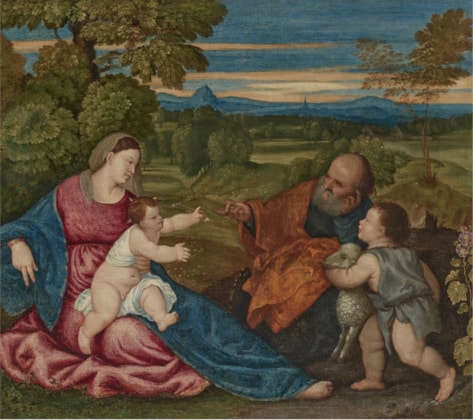lbrecht Adam
(Nördlingen 1786 - Munich 1862)
Austrian Cavalry Resting in a Village
signed ‘Adam’ (lower right)
oil on canvas
46 x 56 cm (18⅛ x 22⅛ in)
In the village square, the recent arrival of a group of Austrian soldiers is causing considerable disturbance. On the right-hand side, a Lancer has dismounted from his horse and has grabbed a woman around her waist. She struggles against his lecherous intentions, knocking his hat to the floor. On the left-hand side, another villager, presumably the woman’s husband, remonstrates with another two soldiers, who try their best to pacify him. Slightly beyond these figures more of the cavalrymen sit in a horse-drawn cart, talking to some locals whilst the animal is refreshed. The soldiers are identifiable as members of the Austro-Hungarian cavalry due to their distinctive uniforms. Many of the figures are Uhlans, or Lancers, who were generally recruited from the Polish speaking parts of the empire, and are easily identifiable by the distinctive four-pointed caps, or Czapka, which they wear. However, Albrecht Adam has also depicted both Dragoons, with their bright red breeches and blue tunics, and Hussars in the work, so that we are given a varied view of the Austro-Hungarian cavalry. In a similar vein, Adam demonstrates his skill as a equine painter, by choosing to depict this three horses with different coat colours and in a variety of poses. The equally adept depiction of chestnut, bay and grey coats, gives the work subtle variety, as well as evidencing Adam’s technical virtuosity as a horse painter.
Austrian Cavalry Resting in a Village, which can be dated to c.1821-1834, is an especially interesting work in the context of Adam’s career, in that it reflects both his work as an equine painter and as a battle painter. He spent much of his early career as a military artist, making numerous battle scenes, scenes of army life, and focused portraits of illustrious officers. The Hermitage’s In the Environs of Viazma on 28 August 1812, is a typical example of these works, comparable to Austrian Cavalry Resting in a Village, in that it shows soldiers at ease, and demonstrates the attention to detail in the soldiers’ uniforms. In the distant valley one can see columns of marching soldiers and Adam was clearly acutely aware of the all aspects of military life. However, although the present work is in some respects a scene of military life, it is also a brilliant and focused equine study, of the type which brought Adam his considerable reputation, such as Thoroughbreds in a Paddock (Private Collection). Both this and the present work show the same mastery of equine anatomy and pose, as Adam captures the sleek elegance of his subject.
Adam first came to prominence for his battle paintings from Napoleon’s campaign in Russia, which he executed whilst court painter to Prince Eugène de Beauharnais. As his reputation as one of the great horse painters of his generation grew, he received commissions from illustrious patrons throughout Europe. His work ranged in scale, from panoramic battle scenes to individual portraits of horses and their owners, and Austrian Cavalry Resting in a Village encompasses many of the best features of his style.
In the village square, the recent arrival of a group of Austrian soldiers is causing considerable disturbance. On the right-hand side, a Lancer has dismounted from his horse and has grabbed a woman around her waist. She struggles against his lecherous intentions, knocking his hat to the floor. On the left-hand side, another villager, presumably the woman’s husband, remonstrates with another two soldiers, who try their best to pacify him. Slightly beyond these figures more of the cavalrymen sit in a horse-drawn cart, talking to some locals whilst the animal is refreshed. The soldiers are identifiable as members of the Austro-Hungarian cavalry due to their distinctive uniforms. Many of the figures are Uhlans, or Lancers, who were generally recruited from the Polish speaking parts of the empire, and are easily identifiable by the distinctive four-pointed caps, or Czapka, which they wear. However, Albrecht Adam has also depicted both Dragoons, with their bright red breeches and blue tunics, and Hussars in the work, so that we are given a varied view of the Austro-Hungarian cavalry. In a similar vein, Adam demonstrates his skill as a equine painter, by choosing to depict this three horses with different coat colours and in a variety of poses. The equally adept depiction of chestnut, bay and grey coats, gives the work subtle variety, as well as evidencing Adam’s technical virtuosity as a horse painter.
Austrian Cavalry Resting in a Village, which can be dated to c.1821-1834, is an especially interesting work in the context of Adam’s career, in that it reflects both his work as an equine painter and as a battle painter. He spent much of his early career as a military artist, making numerous battle scenes, scenes of army life, and focused portraits of illustrious officers. The Hermitage’s In the Environs of Viazma on 28 August 1812, is a typical example of these works, comparable to Austrian Cavalry Resting in a Village, in that it shows soldiers at ease, and demonstrates the attention to detail in the soldiers’ uniforms. In the distant valley one can see columns of marching soldiers and Adam was clearly acutely aware of the all aspects of military life. However, although the present work is in some respects a scene of military life, it is also a brilliant and focused equine study, of the type which brought Adam his considerable reputation, such as Thoroughbreds in a Paddock (Private Collection). Both this and the present work show the same mastery of equine anatomy and pose, as Adam captures the sleek elegance of his subject.
Adam first came to prominence for his battle paintings from Napoleon’s campaign in Russia, which he executed whilst court painter to Prince Eugène de Beauharnais. As his reputation as one of the great horse painters of his generation grew, he received commissions from illustrious patrons throughout Europe. His work ranged in scale, from panoramic battle scenes to individual portraits of horses and their owners, and Austrian Cavalry Resting in a Village encompasses many of the best features of his style.





 contact
contact contact
contact +44 20 7313 8040
+44 20 7313 8040









